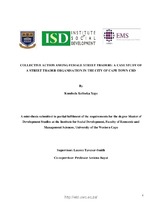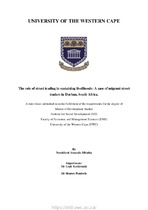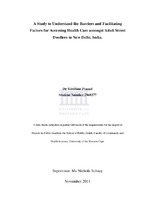| dc.description.abstract | Background: Street foods (SF) contribute significantly to the nutritional intake of adults and children in developing countries. They are inexpensive and a major source of income for a vast multitude. A major concern is the so-called ‘nutrition transition’, which has led to an increase in foods high in saturated fats, trans fats, sugar and salt, along with processed food items sold on urban community streets in developing countries. These foods contribute to nutritional disorders in the communities where consumed. South Africa’s stable unemployment rate, estimated at 25%, has further influenced business growth in the informal sector, particularly SF vending. As such, a well-developed SF-vending model (SFVM) could potentially address the challenges of unemployment and improve the nutritional status of poorer South Africans. Aim: To develop a sustainable SFVM for selling healthy and safe SF in the City of Cape Town enabling street vendors to make a decent living, and consumers to make healthy choices regarding food purchasing. Methods: This cross-sectional study employed mixed methodology (collecting qualitative and quantitative data). The study was conducted in three phases. Phase 1a: Situation Analysis. This a SF-vendor survey which collected a) socio-demographic factors, b) vendors’ business operational models, c) food items sold, d) available facilities, e) challenges faced, f) certification, and g) nutrition knowledge using a validated questionnaire. An observational checklist capturing data on the appearance of vendors, their stalls, available equipment and type of food sold, supplemented this survey. Phase 1b: A consumer survey included collecting, a) socio-demographic factors, b) purchasing habits, c) consumption preferences, and d) nutrition knowledge using a validated questionnaire. Phase 2a: Semi-structured-interviews and focus group discussions with Environmental Health Officials and Economic Development Officials from the City of Cape Town were conducted to explore the existing -vending regulations and/or policies in the City of Cape Town and gain insight into the SF-vending operations from a regulatory perspective. Phase 2b: A document review was conducted to identify existing regulations and policies on SF vending. Phase 3: conducted in three steps: Step 1, data integration of the previous phases. Step 2, a participatory action research component checking the relevance, acceptability and practicability of identified themes and resulting components from Step 1. Step 3, development of the proposed SFVM using the findings of the previous two steps. Data Analysis: Quantitative data were analysed using IBM SPSS, 2010 Statistics version 23. Descriptive statistics and cross-tabulations were used to analyse data. Qualitative data were thematically analysed using the qualitative data software package Atlas ti 7.5.7.Results: Phase 1a: vendors in the Cape Town and surrounding areas work long hours up to seven days a week making a minimal income. Types of food items sold by vendors, their nutrition knowledge and hygiene practices were not ideal. A major lack in basic facilities existed. Phase 2a: SF consumers indicated spending a significant amount of their income on SF, and are open to buying healthier options should these be available. Phase 2a: government officials thought the SF-vending business should be guided by national legislature and provincial bylaws, and felt strongly about nutrition and health education for vendors and consumers. Phase 2b: thirteen regulations and bylaws applicable to SF vending were sourced. Phase 3: Data from the previous phases were integrated within a socio-ecological framework to develop the proposed SFVM. The components of this model are divided into four areas, i.e. a business component, food and nutrition component, hygiene component, and a vending cart. Conclusion: The four components in the proposed SFVM take into account various elements of the socio-ecological framework, i.e. intrapersonal/individual, interpersonal, the physical environment/community and the policy environment. This SFVM should be piloted, evaluated, adapted and before rolling it out on a large scale to test its effectiveness. | en_US |




